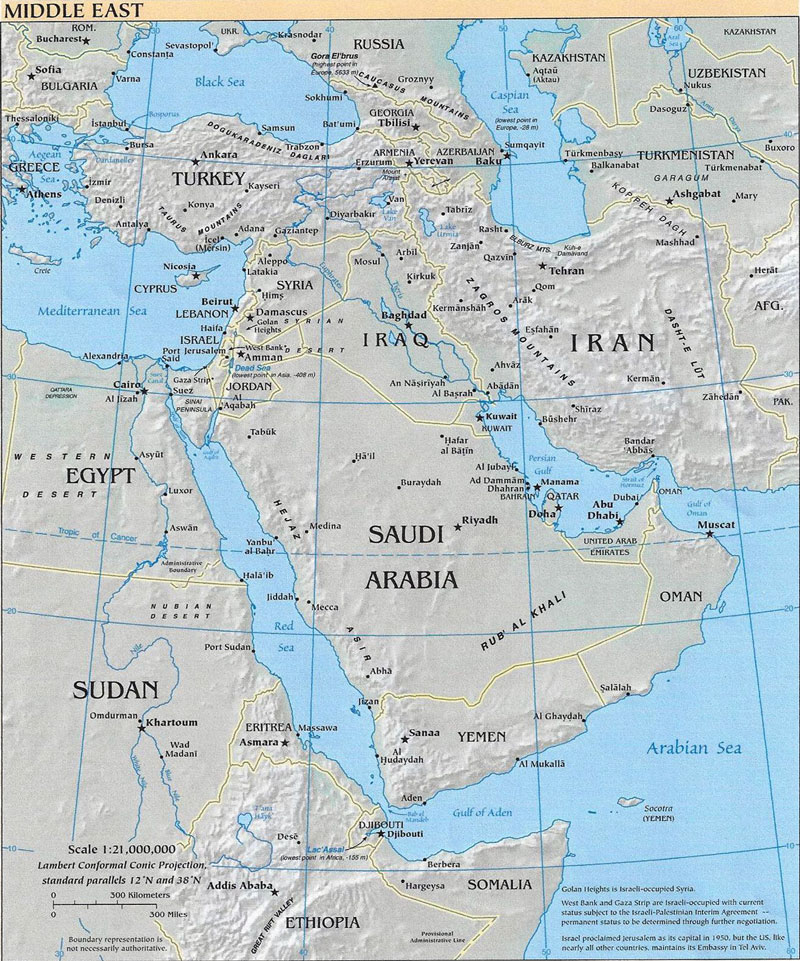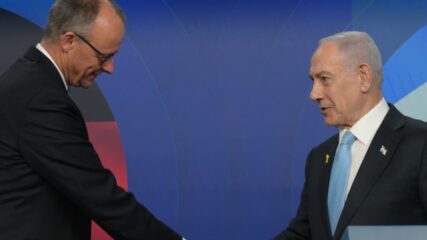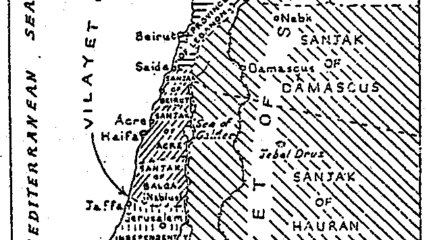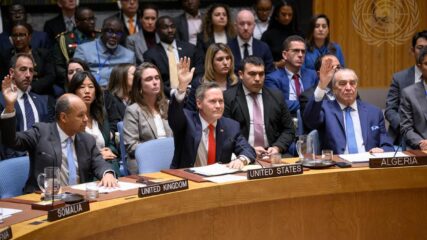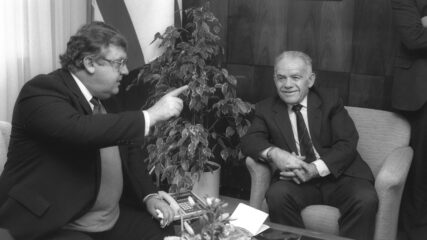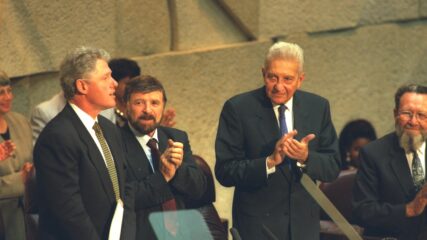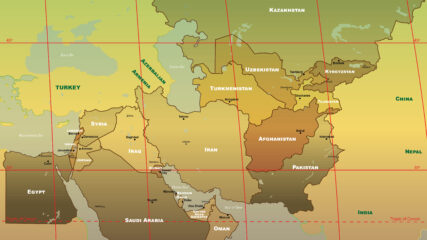Historical Context
Explore the historical context through the events and the documents leading up to the 1991 Madrid Middle East Peace Conference:
- 1949: Israel ends the War of Independence without secure borders or Arab acceptance. The cease-fire lines give Israel more land than proposed by the 1947 U.N. partition plan for Palestine, and the Arab state authorized under that plan is not formed. Egypt holds the Gaza Strip, and Transjordan (soon to be Jordan) holds the West Bank (Judea and Samaria) and the eastern side of Jerusalem with the ancient holy sites.
- 1951-1955: Jordan nears an agreement with Israel until King Abdullah is assassinated. Egypt blocks Israel-bound ships in the Suez Canal and tightens a blockade of the Straits of Tiran, threatening Israel’s oil supply and trade. It also supports terrorist raids that kill Israeli civilians.
- 1956: Israel, backed by France and Britain, invades Egypt and captures the Gaza Strip and Sinai. A cease-fire agreement establishes a U.N.-monitored demilitarized zone along the Egypt-Israel border, and Egypt promises unrestricted navigation in the Gulf of Eilat and the Straits of Tiran.
-
1957-1967: Israel withdraws from the Sinai and Gaza, which Egypt again controls. Israel endures terrorist raids across the Egyptian and Jordanian borders and Syrian artillery bombardment of the Galilee. The Palestine Liberation Organization forms with a dedication to armed struggle, including terrorism, to eliminate Israel. Supported by the Soviet Union, Arab states build up their military forces along Israel’s borders.
Document: PLO National Covenant, May 28, 1964
Significance: The PLO rejects Jewish history, culture and peoplehood, considers all of Israel to be occupied Palestine, and endorses terrorism to help free Palestine.
Excerpt: “Commando action constitutes the nucleus of the Palestinian popular liberation war. This requires its escalation, comprehensiveness, and mobilization of all the Palestinian popular and educational efforts and their organization and involvement in the armed Palestinian revolution. … The liberation of Palestine, from an Arab viewpoint, is a national (qawmi) duty, and it attempts to repel the Zionist and imperialist aggression against the Arab homeland and aims at the elimination of Zionism in Palestine.”
-
1967: Egypt moves large numbers of troops into the Sinai, orders U.N. peacekeepers to leave, again blockades the Straits of Tiran and expands its Arab military alliances. Israel launches a pre-emptive strike against Egypt, Jordan and Syria in June and, in six days of fighting, captures the West Bank and eastern Jerusalem from Jordan, Gaza and the Sinai from Egypt, and the Golan Heights from Syria. In the process, Israel brings nearly 1 million additional Palestinian Arabs under its rule, with many fleeing to refugee camps. The Arab League issues its “three nos” toward Israel: no peace, no recognition and no negotiations. The United Nations embraces the concept of Israel trading land for peace. The Soviet Union ends diplomatic relations with Israel.
Document: Arab League’s Khartoum Resolution, Sept. 1, 1967
Significance: The Arabs’ “three nos” at a summit in Khartoum, Sudan, shock Israeli leaders, many of whom have hoped that the military victory in June would force Arab states to talk peace.
Excerpt: “The Arab Heads of State have agreed to unite their political efforts at the international and diplomatic level to eliminate the effects of the aggression and to ensure the withdrawal of the aggressive Israeli forces from the Arab lands which have been occupied since the aggression of June 5. This will be done within the framework of the main principles by which the Arab States abide, namely, no peace with Israel, no recognition of Israel, no negotiations with it, and insistence on the rights of the Palestinian people in their own country.”
Document: U.N. Security Council Resolution 242, Nov. 22, 1967
Significance: This resolution establishes the principle of exchanging land for peace. By omitting “the” from its discussion of land captured in the war, the measure incorporates ambiguity about how much of the captured territory Israel must return.
Excerpt: “A just and lasting peace in the Middle East … should include the application of both the following principles: “1. Withdrawal of Israel armed forces from territories occupied in the recent conflict; “2. Termination of all claims or states of belligerency and respect for and acknowledgment of the sovereignty, territorial integrity, and political independence of every State in the area and their right to live in peace within secure and recognized boundaries free from threats or acts of force.”
Considering the Arab position, as formulated at the 1967 Khartoum summit above, what policy would you propose to Israel’s Knesset after the victory in the 1967 war?
- 1967-1969: Yigal Allon, a former general and senior member of the government, develops two versions of a plan for Israel to hold strategic borders while offering self-rule to the Palestinians, one in July 1967 and another in October 1969. Israel rejects U.S. Secretary of State William Rogers’ October 1969 proposal for withdrawal to the 1949 armistice lines.
- 1970: Jordan defeats a Palestinian uprising, and the PLO shifts its base to Lebanon. Egypt and Israel end the War of Attrition along the Suez Canal.
- October 1973: Egypt and Syria attack Israel on Yom Kippur. Israel suffers heavy losses but, resupplied by the United States, eventually threatens Cairo and Damascus. The war begins and ends with the same borders.
- 1973-1975: U.N. Security Council Resolution 338 calls for direct Arab-Israeli negotiations. U.S. Secretary of State Henry Kissinger arranges a Geneva peace conference co-sponsored by the Soviet Union as an opportunity for U.S.-mediated talks between Israel and Egypt. Israel reaches two military disengagement agreements with Egypt and one with Syria. The Arab League emphasizes solidarity with the Palestinians and endorses the PLO’s role.
Document: U.N. Security Council Resolution 338, Oct. 22, 1973
Significance: This resolution reaffirms Resolution 242, emphasizes direct negotiations, and provides the basis for a peace conference in December 1973 in Geneva.
Document: Resolution of the Arab League Summit at Rabat, Morocco, October 30, 1974
Significance: The PLO wins recognition from Arab states as the sole representative of the Palestinian people, superseding any role or any land claims by Jordan and Egypt.
- 1977: New U.S. President Jimmy Carter wants to enlist the Soviet Union in a regional approach to Middle East peace. Instead, Egyptian President Anwar Sadat reaches out to new Israeli Prime Minister Menachem Begin and visits Israel, launching direct negotiations.
- 1978: Israel briefly invades Lebanon in response to PLO terrorism. U.N. Security Council Resolution 425 demands Israel’s withdrawal and establishes a peacekeeping force for southern Lebanon. Carter brings Sadat and Begin to Camp David in Maryland, and the leaders hammer out accords that serve as the basis for a peace treaty and call for talks on Palestinian self-rule.
Excerpt: “The Security Council decides that, immediately and concurrently with the cease-fire, negotiations start between the parties concerned under appropriate auspices aimed at establishing a just and durable peace in the Middle East.”
Excerpt: “The conference … affirms the right of the Palestinian people to set up an independent national authority under the leadership of the Palestine Liberation Organization, as the sole legitimate representative of the Palestinian people, on any liberated Palestinian land. The Arab countries will support such an authority once it is established in all spheres.”
Excerpt: “Egypt, Israel, Jordan and the representatives of the Palestinian people should participate in negotiations on the resolution of the Palestinian problem in all its aspects. … Signatories shall establish among themselves relationships normal to states at peace with one another. To this end, they should undertake to abide by all the provisions of the U.N. Charter. Steps to be taken in this respect include: full recognition; abolishing economic boycotts; guaranteeing that under their jurisdiction the citizens of the other parties shall enjoy the protection of the due process of law.”
Document: Camp David Accords, Sept. 17, 1978
Significance: In addition to creating the framework for a treaty between Israel and Egypt, the accords outlined the goal of Palestinian self-rule. - 1979: Egypt and Israel sign a treaty based on trading land (the Sinai) for peace. A radically anti- Israel Islamic government replaces the shah in Iran. The United States supports a U.N. vote calling Israel the occupier of the territories captured in 1967.
- 1982: U.S. President Ronald Reagan offers a plan for a Palestinian entity in the West Bank linked to Jordan, but Begin isn’t consulted and isn’t interested. Israel invades Lebanon to force the PLO out of range of the Galilee, then advances to Beirut. The United States oversees the PLO’s evacuation to Tunis and calls for peace talks. U.S. troops leave Lebanon in 1983; the Israeli army remains until 2000.
- 1985: Jordan and the PLO offer to form a joint delegation to any regional peace conference and suggest that a Palestinian state would join a confederation with Jordan.
- 1986: The Soviet government under President Mikhail Gorbachev begins to loosen restrictions on Jewish emigration. More than 1 million Russian Jews move to Israel by 1995.
- 1987: Israeli Foreign Minister Shimon Peres and Jordanian King Hussein endorse a regional peace conference on the basis of Resolutions 242 and 338 and direct talks between Israel and a joint Jordanian-Palestinian delegation. Prime Minister Yitzhak Shamir rejects the proposal. The First Intifada, a Palestinian uprising against Israeli rule, breaks out in the Gaza Strip and the West Bank; it lasts until 1993.
- 1988: Egyptian President Hosni Mubarak and U.S. Secretary of State George Shultz separately propose an international peace conference. The United States begins talking to the PLO. Hamas, the Palestinian Islamic resistance movement, forms. King Hussein, who annexed the West Bank in 1950, withdraws all claims to the area. The PLO’s Palestinian National Council declares independence.
- 1989: The Soviet Union calls for Israel to negotiate with the PLO. Based on Resolutions 242 and 338 and the Camp David Accords, Israel proposes to negotiate with Palestinians elected in the West Bank and Gaza but not the PLO. Israel seeks a treaty with Jordan and offers a five-year transition to Palestinian self-rule that is short of statehood. U.S. Secretary of State James A. Baker III supports the Israeli proposal as a starting point and floats the idea of a regional peace conference sponsored by the United States and Soviet Union. Mubarak issues a 10-point peace plan with elected Palestinian negotiators. Baker offers a five-point plan mixing the Israeli and Egyptian proposals. The U.N. General Assembly calls for an international peace conference.
- 1990: Israel’s governing coalition collapses. Shamir remains prime minister. Iraq conquers Kuwait. The United States mobilizes an international military coalition in Saudi Arabia to counter Iraq. The Soviet Union doesn’t send troops but supports the coalition. The PLO backs Iraq.
- January: The U.S.-led coalition based in Saudi Arabia launches Operation Desert Storm to liberate Kuwait. Iraq fires Scud missiles at Israel, hoping that an Israeli military response will split the coalition. At U.S. urging, Israel holds its fire. • Feb. 28: The United States declares Kuwait liberated after a 100-hour ground war.
- March 6: In a congressional address, President George H.W. Bush announces a concerted U.S. effort led by Secretary of State James A. Baker III to leverage the war victory into talks for a comprehensive regional peace.
- March-October: Baker repeatedly visits the Middle East, including nine stops in Israel. Bush and Soviet President Mikhail Gorbachev in July announce their intention to hold a regional peace conference in October. Gorbachev survives a coup attempt in August, foreshadowing the breakup of the Soviet Union in December. Bush and Israeli Prime Minister Yitzhak Shamir clash over an Israeli request for $10 billion in loan guarantees to finance housing for the surge in Russian immigrants. Concerned that the money would finance settlement growth, Bush postpones a decision until February 1992. The Soviet Union and Israel restore diplomatic relations for the first time since 1967; the same day, the United States and Soviet Union issue invitations to a peace conference Oct. 30 to Nov. 1 in Madrid. The United States makes private assurances about the conference topics and participants to Israel, Syria, Lebanon and the Palestinians.
Document: U.S.-U.S.S.R. invitation to the Madrid peace conference, Oct. 18, 1991
Significance: The invitees know that they all must agree to turn the Madrid conference into a peace process.
Excerpt: “The United States and the Soviet Union believe that a historic opportunity exists to advance the prospects for genuine peace throughout the region. The United States and the Soviet Union are prepared to assist the parties to achieve a just, lasting and comprehensive peace settlement, through direct negotiations along two tracks, between Israel and the Arab States, and between Israel and the Palestinians, based on United Nations Security Council resolutions 242 and 338. The objective of this process is real peace. … The conference will have no power to impose solutions on the parties or veto agreements reached by them. It will have no authority to make decisions for the parties and no ability to vote on issues or results. The conference can reconvene only with the consent of all the parties.”
Document: Letters of assurance, mid-October
The following are paraphrased highlights of the letters, as reported in various media.
To the Palestinians: The United States is open to any outcome and to discussion of any issue the Palestinians wish to raise. The residents of East Jerusalem should be able to participate in any interim elections. The final status of East Jerusalem is open to negotiation, and no interim arrangements regarding the city will affect the resolution. The United States opposes Israeli annexation of East Jerusalem. The United States opposes stalling and will push for a five-year process from interim arrangements to final agreement.
To Israel: Each set of bilateral negotiations is direct and independent. The PLO is excluded, and Palestinian delegates must live in the West Bank or Gaza. The United States does not support the creation of an independent Palestine. The United States will work to end the Arab boycott and to annul the U.N. resolution equating Zionism with racism. Israel deserves a secure border with Lebanon and negotiated borders with Syria.
To Lebanon: U.N. Security Council Resolution 425, calling for Israel’s withdrawal from Lebanon, is separate from Resolution 242 and applies only to Israel, not to Syria.
To Syria: The United States agrees that simultaneous progress in all the bilateral talks is in the interests of a comprehensive settlement of the Arab-Israeli conflict. Resolution 242 applies to the Golan Heights. The United States won’t recognize unilateral actions by Israel.
From these events and documents, consider whether the political and diplomatic conditions were ripe for successful negotiations.

